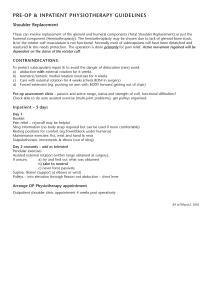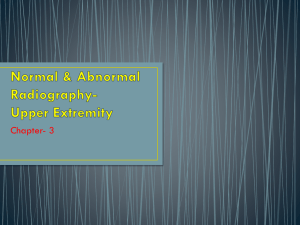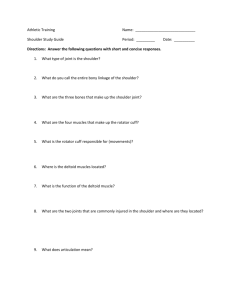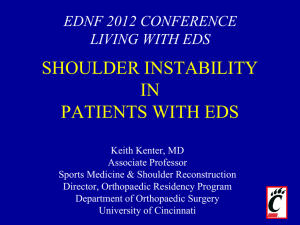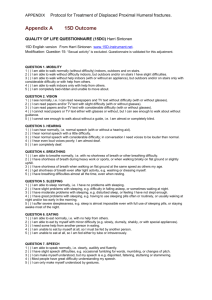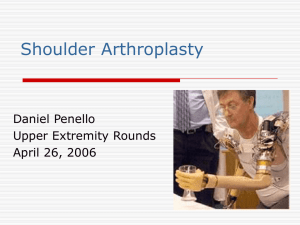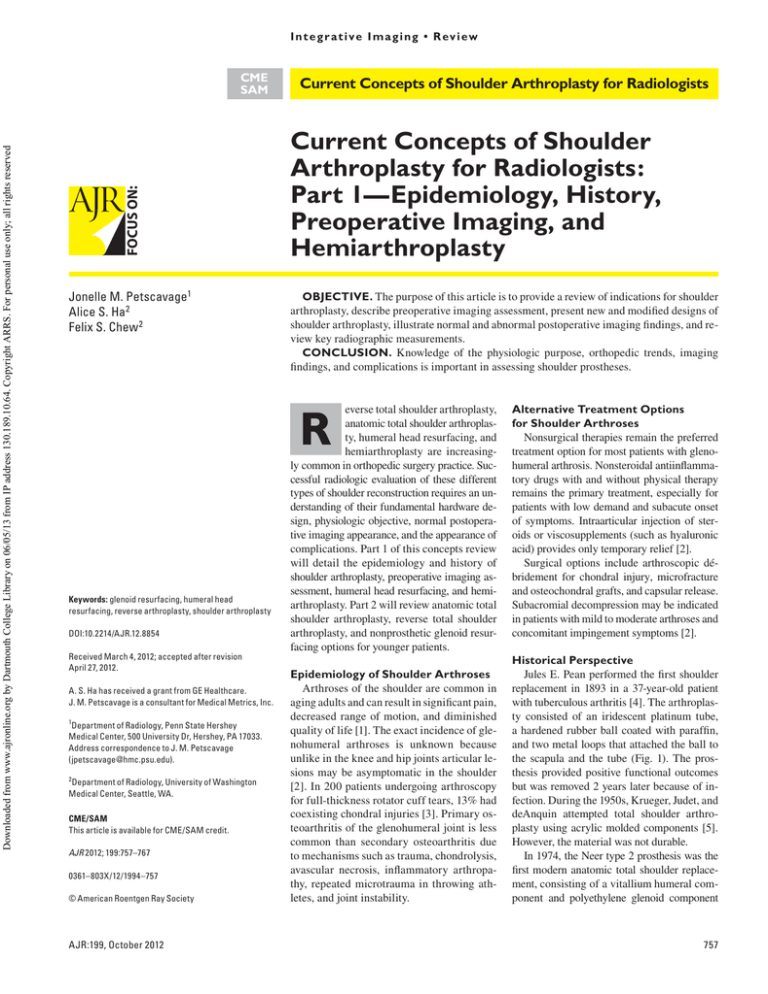
I n t e g r a t i ve I m a g i n g • R ev i ew
Petscavage et al.
Imaging Shoulder Arthroplasty
FOCUS ON:
Downloaded from www.ajronline.org by Dartmouth College Library on 06/05/13 from IP address 130.189.10.64. Copyright ARRS. For personal use only; all rights reserved
Integrative Imaging
Review
CME
SAM
Jonelle M. Petscavage1
Alice S. Ha2
Felix S. Chew 2
Petscavage JM, Ha AS, Chew FS
Current Concepts of Shoulder Arthroplasty for Radiologists
Current Concepts of Shoulder
Arthroplasty for Radiologists:
Part 1—Epidemiology, History,
Preoperative Imaging, and
Hemiarthroplasty
OBJECTIVE. The purpose of this article is to provide a review of indications for shoulder
arthroplasty, describe preoperative imaging assessment, present new and modified designs of
shoulder arthroplasty, illustrate normal and abnormal postoperative imaging findings, and review key radiographic measurements.
CONCLUSION. Knowledge of the physiologic purpose, orthopedic trends, imaging
findings, and complications is important in assessing shoulder prostheses.
R
Keywords: glenoid resurfacing, humeral head
resurfacing, reverse arthroplasty, shoulder arthroplasty
DOI:10.2214/AJR.12.8854
Received March 4, 2012; accepted after revision
April 27, 2012.
A. S. Ha has received a grant from GE Healthcare.
J. M. Petscavage is a consultant for Medical Metrics, Inc.
1
Department of Radiology, Penn State Hershey
Medical Center, 500 University Dr, Hershey, PA 17033.
Address correspondence to J. M. Petscavage
(jpetscavage@hmc.psu.edu).
2
Department of Radiology, University of Washington
Medical Center, Seattle, WA.
CME/SAM
This article is available for CME/SAM credit.
AJR 2012; 199:757–767
0361–803X/12/1994–757
© American Roentgen Ray Society
everse total shoulder arthroplasty,
anatomic total shoulder arthroplasty, humeral head resurfacing, and
hemiarthroplasty are increasingly common in orthopedic surgery practice. Successful radiologic evaluation of these different
types of shoulder reconstruction requires an understanding of their fundamental hardware design, physiologic objective, normal postoperative imaging appearance, and the appearance of
complications. Part 1 of this concepts review
will detail the epidemiology and history of
shoulder arthroplasty, preoperative imaging assessment, humeral head resurfacing, and hemiarthroplasty. Part 2 will review anatomic total
shoulder arthroplasty, reverse total shoulder
arthroplasty, and nonprosthetic glenoid resurfacing options for younger patients.
Epidemiology of Shoulder Arthroses
Arthroses of the shoulder are common in
aging adults and can result in significant pain,
decreased range of motion, and diminished
quality of life [1]. The exact incidence of glenohumeral arthroses is unknown because
unlike in the knee and hip joints articular lesions may be asymptomatic in the shoulder
[2]. In 200 patients undergoing arthroscopy
for full-thickness rotator cuff tears, 13% had
coexisting chondral injuries [3]. Primary osteoarthritis of the glenohumeral joint is less
common than secondary osteoarthritis due
to mechanisms such as trauma, chondrolysis,
avascular necrosis, inflammatory arthropathy, repeated microtrauma in throwing athletes, and joint instability.
Alternative Treatment Options
for Shoulder Arthroses
Nonsurgical therapies remain the preferred
treatment option for most patients with glenohumeral arthrosis. Nonsteroidal antiinflammatory drugs with and without physical therapy
remains the primary treatment, especially for
patients with low demand and subacute onset
of symptoms. Intraarticular injection of steroids or viscosupplements (such as hyaluronic
acid) provides only temporary relief [2].
Surgical options include arthroscopic débridement for chondral injury, microfracture
and osteochondral grafts, and capsular release.
Subacromial decompression may be indicated
in patients with mild to moderate arthroses and
concomitant impingement symptoms [2].
Historical Perspective
Jules E. Pean performed the first shoulder
replacement in 1893 in a 37-year-old patient
with tuberculous arthritis [4]. The arthroplasty consisted of an iridescent platinum tube,
a hardened rubber ball coated with paraffin,
and two metal loops that attached the ball to
the scapula and the tube (Fig. 1). The prosthesis provided positive functional outcomes
but was removed 2 years later because of infection. During the 1950s, Krueger, Judet, and
deAnquin attempted total shoulder arthroplasty using acrylic molded components [5].
However, the material was not durable.
In 1974, the Neer type 2 prosthesis was the
first modern anatomic total shoulder replacement, consisting of a vitallium humeral component and polyethylene glenoid component
AJR:199, October 2012757
Downloaded from www.ajronline.org by Dartmouth College Library on 06/05/13 from IP address 130.189.10.64. Copyright ARRS. For personal use only; all rights reserved
Petscavage et al.
[6]. These implants were successful except for
high failure rates of glenoid loosening and superior impingement in patients with rotator
cuff deficiency. In response, in 1985, the reverse total shoulder arthroplasty was designed
to shift the center of rotation at the shoulder
joint and compensate for those with a deficient
rotator cuff [7].
Charles Neer [8] implanted the first hemiarthroplasty for a humeral head fracture in the
1950s. Modifications in this design have occurred in combination with advances in anatomic total shoulder arthroplasty because similar stemmed humeral components are used.
Meanwhile, Steffee and Moore [9] placed the
first humeral head resurfacing in the late 1970s
using a hip resurfacing implant to fit the dimensions of the humeral head. The goal of the design was to retain the humeral neck and > 50%
of the humeral head to restore normal biomechanics. A recent biomechanical study
showed lower rates of glenoid wear with resurfacing arthroplasty than standard hemiarthroplasty designs [10]. A new concept in the
past 5 years is use of partial resurfacing of
the humeral head for focal osteochondral defects, trauma, and avascular necrosis.
Ultimately, over the past several decades,
more than 70 modifications in prosthetic shoulder design have been made. This article will review the currently used prosthetic designs.
Epidemiology of Shoulder
Arthroplasty
There was a steady increase in the number
of both hemiarthroplasty and total shoulder
arthroplasty procedures performed in the United States between 1993 and 2008 [11]. With
an overall aging population, more than two
thirds of the total shoulder arthroplasties are
performed annually on patients older than 65
years. Kim et al. [11] noted a relative increase
of total shoulder arthroplasty over hemiarthroplasty starting in 2003, likely related to introduction of the reverse total shoulder arthroplasty. In 2008 alone, approximately 27,000
total shoulder arthroplasties and 20,000 hemiarthroplasties were performed [11]. Osteoarthritis accounted for the primary diagnoses in
77% of total shoulder arthroplasty cases and
43% of hemiarthroplasty cases. The second
most common diagnosis for hemiarthroplasty
was proximal humeral fracture (33%).
Preoperative Radiologic Evaluation
and Measurements
Several important radiologic assessments
should be made on preoperative imaging stud-
758
ies. Rotator cuff integrity impacts the type of
arthroplasty placed. Tendon tears and fatty
muscle degeneration of the rotator cuff, particularly the infraspinatus, have been shown
to correlate with reduced acromiohumeral distance [12]. On an anteroposterior radiograph,
an acromiohumeral distance ≤ 7 mm with superior subluxation of the humeral head suggests a large rotator cuff tear (Fig. 2). Other
findings indicative of multiple tendon tears
include greater tuberosity sclerosis or irregularity, cysts at the greater tuberosity, “acetabularization” of the acromion (remodeling
of undersurface due to high riding humeral
head), and exaggerated groove between the
greater tuberosity and the humeral articular
surface [13]. In equivocal cases without these
radiographic findings, ultrasound or MRI can
be used to differentiate tears without tendon
retraction from partial tears or an intact cuff.
Contracture or tear of the subscapularis
tendon can result in anterior instability if not
corrected or recognized preoperatively [14].
Preoperative radiographs should be assessed
for anterior subluxation of the humerus on
the axillary view. The humeral head is considered centered in the glenoid if the distance
between the center of the humeral head and
the center of the glenoid are within 25% of
the humeral head diameter.
Another important preoperative assessment
is the glenoid fossa morphology. In moderate
to severe glenohumeral osteoarthritis, erosive
changes and wear are usually greater in the
posterior half of the glenoid articular surface,
thus increasing glenoid retroversion [15]. The
Walch classification of glenoid morphology is
assessed on axillary radiographs or CT (Fig.
3). Type A morphology is a centered humeral
head with (A1) minor or (A2) major erosions.
Type B describes a posteriorly subluxed humeral head with (B1) posterior joint space narrowing and osteophytes or (B2) posterior rim
erosions and glenoid retroversion (> 2°). Type
C is the most severe, with glenoid retroversion
of more than 25°.
Studies have shown that failure to correct
glenoid retroversion predisposes to joint instability, posterior subluxation, and glenoid
component loosening due to abnormal forces
across the implant and cement-bone interfaces
[16]. It is recommended that surgeons either
graft the erosions or ream the glenoid in an attempt to align the glenoid prosthesis perpendicular to the scapular axis. Before CT, the
glenoid version was measured on axillary radiographs. However, radiographs have been
shown ineffective in assessing the glenoid
version because of overlapping bones, variation in radiographic technique, and variability
and complexity of scapular anatomy [17].
Friedman et al. [18] defined the glenoid
version as the angle between a line drawn
from the medial border of the scapula to the
center of the glenoid and the line perpendicular to the face of the glenoid on the axial 2D
CT slice at or just below the tip of the coracoid
(Fig. 4A). However, axial 2D CT version measurements depend on the relation of the plane
of the scapula to the axis of the CT scanner. It
has been shown that every 1° of abduction of
the scapula increases the value of glenoid anteversion by a mean of 0.42° [19]. Hoenecke
et al. [20] showed 3D CT to be more accurate
in detecting posterior glenoid erosion. Another study showed greater than 5° difference in
measurements of version between 2D CT and
3D CT images in nearly 50% of patients [21].
Thus, 3D CT is suggested as the most accurate preoperative means of assessing glenoid
version and morphology. On 3D CT, a vertical line can be drawn on the 3D surface of the
glenoid face, centered in the anteroposterior
direction (Fig. 4B). A transverse 2D plane is
then generated perpendicular to the midpoint
of the vertical line passing through the scapular axis (center of glenoid and tip of scapular
spine) to obtain an image for glenoid version
angle measurement [21] (Fig. 4C).
Humeral Head Resurfacing
Indications
The concept of humeral head resurfacing
was introduced as a means of preserving the
humeral head in younger active patients, allowing native humeral head inclination and humeral head-shaft angle [22]. The native humeral
head-shaft angle is intact because no osteotomy is performed [23]. This bypasses the risk of
periprosthetic fracture of the humeral shaft in
a stemmed implant and preserves bone stock
for future revision surgery [24]. Additionally, it
is an option for patients with extraarticular humeral deformities, such as malunited proximal
humeral fractures and congenital defects.
The procedure involves reaming of the
proximal portion of the humeral head and fitting a metal-alloy cap over the remainder of
the humeral head. This can be paired with a
glenoid component if desired. Contraindications of humeral head resurfacing include inadequate bone stock and four-part humeral
fractures [23]. Several studies have shown
improved postoperative Constant scores and
functional outcomes after resurfacing arthroplasty [25, 26].
AJR:199, October 2012
Downloaded from www.ajronline.org by Dartmouth College Library on 06/05/13 from IP address 130.189.10.64. Copyright ARRS. For personal use only; all rights reserved
Imaging Shoulder Arthroplasty
Partial humeral head resurfacing is indicated for osteonecrosis, focal osteoarthritis
of the humeral head, cuff tear arthropathy,
focal erosions, Hill-Sachs lesions, and focal
chondral defects of the humerus [24]. Benefits include fewer MRI and CT artifacts, intact soft-tissue envelope and bone anatomy
of the joint, and shorter surgical time. The
largest series of patients undergoing partial
humeral head resurfacing showed that 95%
of patients reported good-to-excellent results
and had improved Constant scores [27].
Design
Total humeral head resurfacing consists
of a cemented or press-fit metal articularcapped component stabilized by a grooved
stem of variable shape, diameter, and length
(Fig. 5). Partial resurfacing involves an articular cobalt-chromium-alloy surface component with a small central peg that mates with
a tapered post, which is a headless titaniumalloy cannulated screw (Fig. 6).
Imaging
On radiographs, the resurfacing cap should
be flush against the bone and centered on the
glenoid on the lateral view. There should be
no radiolucency surrounding the peg. Reported complications of humeral head resurfacing include loosening, particularly on the
glenoid side; proximal migration of the cup
and glenoid wear; arthrofibrosis; subscapularis tendon rupture; instability with subluxation (Fig. 7); and two cases of periprosthetic fracture [22, 24]. The main clinical trials
have shown no complications of partial humeral head resurfacing [24, 27].
Hemiarthroplasty
Indications
Hemiarthroplasty is indicated in patients
with severe proximal humerus fractures (3- or
4-part), arthritis in which glenoid bone stock is
inadequate to support a prosthesis, and osteonecrosis or osteoarthritis without glenoid involvement [28, 29]. Hemiarthroplasty is not
preferred for moderate or severe osteoarthritis
because a meta-analysis of 23 trials showed total shoulder arthroplasty to provide significantly greater pain relief, forward elevation, gain
in forward elevation and external rotation, patient satisfaction, and lower revision rates when
compared with hemiarthroplasty [30].
Design
Hemiarthroplasty usually consists of the
stemmed metal humeral component of ana-
tomic total shoulder arthroplasty without an accompanying glenoid component (Fig. 8A). The
humeral component is a minimally constrained
anatomic implant consisting of a spherical metal
articular surface and cemented or press-fit metal
stem. In patients with rotator cuff tears and narrowing of the acromial-humeral distance, an extended-coverage humeral head (cuff tear arthroplasty) design may be used (Fig. 8B). The head
extends laterally over the greater tuberosity, decreasing contact and impingement between
the acromion and greater tuberosity. The head
should not overhang anteriorly because of the
risk of impingement on the subscapularis tendon [29].
Unlike the smooth contour of the original
Neer components, modern humeral components are surface-textured or cemented. Cementing offers the advantages of lower mechanical failure, ability to add antibiotics to
the cement to prevent infection, and stability
in patients with poor bone stock. Disadvantages include difficulty of removal at revision surgery and rare cases of radial nerve injury from
cement extrusion [31].
Oncologic humeral prostheses may or may
not allow reconstruction of the rotator cuff
for additional joint stability (Fig. 9). Rotator
cuff reconstruction requires suture holes in
the humeral prosthesis for direct attachment
or a nylon/polyester (Dacron, Invista) mesh
capsuloplasty for indirect attachment of the
rotator cuff [32].
Imaging and Issues in Hemiarthroplasty
Routine radiographs should include true anteroposterior views in both internal and external rotation and an axillary view. The humeral
stem should be centered in the humeral shaft.
The complication of excessive lateral or medial translation can result in altered load distribution, cortical bone resorption, and rotator
cuff and deltoid insufficiency [33]. The height
of the humeral component should be 2–5 mm
measured between a line perpendicular to the
greater tuberosity and a second line along the
head of the prosthesis. Subsidence reflects a
decrease in this vertical distance and is a clinically significant complication if the distance
changes by > 5 mm [34] (Fig. 10A). Additionally, an increase in this vertical distance resulting in an acromial humeral distance < 2 mm
(Fig. 9B) reflects either overstuffing, new rotator cuff tear, subacromial impingement from
acromial spurs, or “overstuffing” from too
large a head component [33].
The axillary view is best for assessing anterior or posterior subluxation of the humeral head,
classified as absent, slight (translation < 25%),
moderate (25–50%), or severe (> 50%) [35]
(Fig. 11). Additional radiographic complications of hemiarthroplasty include glenoid erosions and arthritis, occurring in up to 64% of
patients [28] (Fig. 12). Subscapularis tendon
tearing is a unique complication of cuff tear
arthroplasty design and is seen on radiographs
as progressive anterior subluxation of the humeral component.
Radiolucency about the humeral component > 0.5 mm should be noted for size,
progression, and location because it may
represent aseptic loosening or small-particle disease related to polyethylene or methyl methacrylate cement. Radiolucency with
periostitis and soft-tissue swelling should
raise suspicion of deep infection, which is reported to occur in 0–3.9% of cases (Fig. 13A).
Staphylococcus aureus, Staphylococcus epidermidis, and Propionibacterium acnes are
the most commonly isolated organisms from
the cultures of postoperative shoulder infections [36]. Infection is primarily treated with
explantation of the arthroplasty and placement of an antibiotic-impregnated spacer either prefabricated or mixed with cement and
stabilized by a Steinmann pin (Fig. 13B).
Stress shielding is long-term complication
of hemiarthroplasty and a risk factor for aseptic
loosening and periprosthetic fracture. “Stress
shielding” is the term used to describe adaption
of periprosthetic bone to changes in stress distribution that are induced by the humeral stem
component [37]. Stress shielding has an incidence of approximately 9%. On imaging, stress
shielding appears as bone (cortical) thinning
and increased internal porosity (Fig. 14).
Incidence of intraoperative fracture is reported as 1.2% during primary arthroplasty and 3.3% during revision shoulder arthroplasty, with a 2.9 relative risk using press-fit
compared with cemented humeral stems [38].
Fractures involving the tuberosities (region 1
fractures) may not require fixation but if displaced are typically treated with suture fixation of the fractured tuberosity to the humeral implant and circumferentially around the
proximal part of the humerus. Region 2 fractures, those involving the metaphysis, also undergo cerclage fixation with autologous bone
grafting. Longer-stemmed humeral implants
may be used for intraoperative fractures involving the proximal, mid, or distal humeral
diaphysis (region 3 and 4 fractures).
Postoperative fracture incidence is 1.6–2.4%,
usually due to trauma [39]. The Wright and Cofield [39] classification scheme for fractures is
AJR:199, October 2012759
Downloaded from www.ajronline.org by Dartmouth College Library on 06/05/13 from IP address 130.189.10.64. Copyright ARRS. For personal use only; all rights reserved
Petscavage et al.
based on degree of proximal extension (Fig.
15). For patients undergoing hemiarthroplasty for treatment of proximal humeral fracture, poorer subjective outcomes and lower
rates of postoperative arm elevation are seen
when the tuberosity fragment displaces more
than 0.5 cm or fails to heal [40]. Thus, attention should be made to healing and change of
alignment of the preoperative fracture.
In addition to the previously mentioned
complications, oncologic humeral prostheses
are at risk of failure of allograft incorporation,
larger area of heterotopic ossification formation, and tumor recurrence (Fig. 16). Rates of
recurrence vary depending on factors such as
primary histology and extent of initial tumor.
Conclusion
Knowledge of indications, component construction, normal postoperative imaging assessment and measurements, and findings of complications is important for providing a meaningful
radiologic evaluation of shoulder arthroplasty.
References
1.Hill CL, Gill TK, Shanahan EM, Taylor AW.
Prevalence and correlates of shoulder pain and
stiffness in a population-based study: the North
West Adelaide Health Study. Int J Rheum Dis
2010; 13:215–222
2.Boselli KJ, Ahmad CS, Levine WN. Treatment of
glenohumeral arthrosis. Am J Sports Med 2010;
38:2558–2572
3.Gartsman GM, Taverna E. The incidence of glenohumeral joint abnormalities associated with
full-thickness, reparable rotator cuff tears. Arthroscopy 1997; 13:450–455
4.Lugli T. Artificial shoulder joint by Pean (1893):
the facts of an exceptional intervention and the
prosthetic method. Clin Orthop Relat Res 1978;
133:215–218
5.Gross RM. The history of total shoulder arthroplasty. In: Crosby LA, ed. Total shoulder arthroplasty. Rosemont, IL: American Academy of Orthopedic Surgeons, 2000:1–15
6.Neer CS 2nd, Watson KC, Stanton FJ. Recent experience in total shoulder replacement. J Bone
Joint Surg Am 1982; 64:319–337
7.Grammont P, Trouilloud P, Laffay JP, Deries X.
Concept study and realization of a new total
shoulder prosthesis [in French]. Rheumatologie
1987; 39:407–418
8.Neer CS 2nd. Articular replacement for the humeral
head. J Bone Joint Surg Am 1955; 37:215–228
9.Steffee AD, Moore RW. Hemi-resurfacing arthroplasty of the shoulder. Contemp Orthop 1984;
9:51–59
10.Hammond G, Tibone JE, McGarry MH, Jun BJ,
760
Lee TQ. Biomechanical comparison of anatomic
humeral head resurfacing and hemiarthroplasty
in functional glenohumeral positions. J Bone
Joint Surg Am 2012; 94:68–76
11.Kim SH, Wise BL, Zhang Y, Szabo RM. Increasing
incidence of shoulder arthroplasty in the United
States. J Bone Joint Surg Am 2011; 93:2249–2254
12.Saupe N, Pfirrmann CW, Schmid MR, Jost B,
Werner CM, Zanetti M. Association between rotator cuff abnormalities and reduced acromiohumeral distance. AJR 2006; 187:376–382
13.Norwood LA, Barrack R, Jacobson KE. Clinical
presentation of complete tears of the rotator cuff.
J Bone Joint Surg Am 1989; 71:499–505
14.Fealy S, Sperling JW, Warren RF, Craig EV. Shoulder arthroplasty: complex issues in the primary and
revision setting. New York, NY: Thieme, 2008
15.Walch G, Badet R, Boulahia A, Khoury A. Morphologic study of the glenoid in primary glenohumeral
osteoarthritis. J Arthroplasty 1999; 14:756–760
16.Farron A, Terrier A, Buchler P. Risks of loosening
of a prosthetic glenoid implanted in retroversion. J
Shoulder Elbow Surg 2006; 15:521–526
17.Nyffeler RW, Jost B, Pfirrmann CW, Gerber C.
Measurement of glenoid version: conventional radiographs versus computed tomography scans. J
Shoulder Elbow Surg 2003; 12:493–496
18.Friedman RJ, Hawthorne KB, Genez BM. The
use of computerized tomography in the measurement of glenoid version. J Bone Joint Surg Am
1992; 74:1032–1037
19.Bryce CD, Davison AC, Lewis GS, Wang L,
Flemming DJ, Armstrong AD. Two-dimensional
glenoid version measurements vary with coronal
and sagittal scapular rotation. J Bone Joint Surg
Am 2010; 92:692–699
20.Hoenecke HR Jr, Hermida JC, Flores-Hernandez
C, D’Lima DD. Accuracy of CT-based measurements of glenoid version for total shoulder arthroplasty. J Shoulder Elbow Surg 2010; 19:166–171
21.Budge MD, Lewis GS, Schaefer E, Coquia S,
Flemming DJ, Armstrong AD. Comparison of
standard two-dimensional and three-dimensional
corrected glenoid version measurements. J Shoulder Elbow Surg 2011; 20:577–583
22.Copeland SA. Cementless total shoulder replacement. In: Post M, Morrey BF, Hawkins RJ, eds.
Surgery of the shoulder. St. Louis, MO: Mosby
Year Book, 1990:289–293
23.Burgess DL, McGrath MS, Bonutti PM, et al.
Shoulder resurfacing. J Bone Joint Surg Am 2009;
91:1228–1238
24.Uribe JW, Botto-van Bemden A. Partial humeral
head resurfacing for osteonecrosis. J Shoulder Elbow Surg 2009; 18:711–716
25.Thomas SR, Wilson AJ, Chambler A, Harding I,
Thomas M. Outcome of Copeland surface replacement shoulder arthroplasty. J Shoulder El-
bow Surg 2005; 14:485–491
26.Buchner M, Eschbach N, Loew M. Comparison of
the short-term functional results after surface replacement and total shoulder arthroplasty for osteoarthritis of the shoulder: a matched-pair analysis. Arch Orthop Trauma Surg 2008; 128:347–354
27.Scalise JJ, Miniaci A, Iannotti JP. Resurfacing
arthroplasty of the humerus: indications, surgical
techniques and clinical results. Tech Shoulder Elbow Surg 2007; 8:152–160
28.Wiater JM, Fabing MH. Shoulder arthroplasty:
prosthetic options and indications. J Am Acad Orthop Surg 2009; 17:415–425
29.Boileau P, Sinnerton RJ, Chuinard C, Walch G.
Arthroplasty of the shoulder. J Bone Joint Surg Br
2006; 88:562–575
30.Radnay CS, Setter KJ, Chambers L, Levine WN,
Bigliani LU, Ahmad CS. Total shoulder replacement compared with humeral head replacement
for the treatment of primary glenohumeral osteoarthritis: a systematic review. J Shoulder Elbow
Surg 2007; 16:396–402
31.Sanchez-Sotelo J. Total shoulder arthroplasty.
Open Orthop J 2011; 5:106–114
32.Thai DM, Kitagawa Y, Choong PF. Outcome of
surgical management of bony metastases to the
humerus and shoulder girdle: a retrospective analysis of 93 patients. Int Semin Surg Oncol 2006; 3:5
33.Merolla G, Di Pietto F, Romano S, Paladini P,
Campi F, Porcellini G. Radiographic analysis of
shoulder anatomical arthroplasty. Eur J Radiol
2008; 68:159–169
34.Sanchez-Sotelo J, Wright TW, O’Driscoll SW, Cofield RH, Rowland CM. Radiographic assessment
of uncemented humeral components in total shoulder arthroplasty. J Arthroplasty 2001; 16:180–187
35.Sperling JW, Cofield RH, Rowland CM. Minimum fifteen-year follow-up of Neer hemiarthroplasty and total shoulder arthroplasty in patients
aged fifty years or younger. J Shoulder Elbow
Surg 2004; 13:604–613
36.Saltzman MD, Marecek GS, Edwards SL, Kalainov DM. Infection after shoulder surgery. J Am
Acad Orthop Surg 2011; 19:208–218
37.Nagels J, Stokdijk M, Rozing PM. Stress shielding
and bone resorption in shoulder arthroplasty. J
Shoulder Elbow Surg 2003; 12:35–39
38.Athwal GS, Sperling JW, Rispoli DM, Cofield RH.
Periprosthetic humeral fractures during shoulder arthroplasty. J Bone Joint Surg Am 2009; 91:594–603
39.Wright TW, Cofield RH. Humeral fractures after
shoulder arthroplasty. J Bone Joint Surg Am 1995;
77:1340–1346
40.Kralinger F, Schwaiger R, Wambacher M, et al.
Outcome after primary hemiarthroplasty for fracture of the head of the humerus: a retrospective
multicenter study of 167 patients. J Bone Joint
Surg Br 2004; 86:217–219
AJR:199, October 2012
Downloaded from www.ajronline.org by Dartmouth College Library on 06/05/13 from IP address 130.189.10.64. Copyright ARRS. For personal use only; all rights reserved
Imaging Shoulder Arthroplasty
Fig. 1—Photograph taken at Smithsonian National
Museum of History shows first shoulder replacement
placed by Jules E. Pean in patient with tuberculous
arthritis. Arthroplasty consists of iridescent platinum
tube, hardened rubber ball coated with paraffin, and
two metal loops that attach ball to scapula and tube.
Fig. 2—Narrowed acromial-humeral distance.
Anteroposterior radiograph of right shoulder in
81-year-old man with osteoarthritis shows severe
narrowing of acromial-humeral distance to less
than 7 mm (arrow), with “acetabularization” of
undersurface of acromion. Also seen is severe
narrowing of glenohumeral joint with subchondral
sclerosis, subchondral cysts, and osteophytes.
Findings are consistent with osteoarthritis.
Type A = Centered humeral head
A1
A2
Minor erosion
Major erosion
Type B = Posteriorly subluxed humeral head
B1
Posterior narrowing
osteophytes, sclerosis
B2
Posterior + Retroverted
rim erosion
glenoid
Type C = Glenoid retroversion
> 25° regardless of erosion
C
Fig. 3—Walch glenoid morphology scale. Illustration
shows grading of glenoid morphology, focusing on
presence of glenoid erosions, posterior subluxation,
and glenoid retroversion. Osteoarthritis more
commonly results in posterior version and posterior
erosions whereas inflammatory arthritis results in
central erosions.
AJR:199, October 2012761
Downloaded from www.ajronline.org by Dartmouth College Library on 06/05/13 from IP address 130.189.10.64. Copyright ARRS. For personal use only; all rights reserved
Petscavage et al.
A
B
Fig. 4—Calculation of glenoid version in 53-year-old man with posttraumatic
osteoarthritis.
A, On axial 2D CT image in bone windows, at or just below tip of coracoid, line
is drawn from medial border of scapula to center of glenoid (white arrow). Line
perpendicular to this is drawn (black arrow). Angle between this line and line
perpendicular to face of glenoid (white line) is version angle. In this patient,
glenoid is retroverted by 7°, which is abnormal.
B, Three-dimensional volume-rendered image of glenoid face shows method for
version calculation. Vertical line (white line) is drawn on 3D surface of glenoid
face, centered in anteroposterior direction. Transverse 2D plane is generated by
drawing line (black line) perpendicular to midpoint of white line to pass through
scapular axis.
C, Glenoid version angle is then measured at level of transverse plane using
Friedman technique for 2D CT slice. Here, angle measures 13°, which is abnormal.
C
A
762
B
Fig. 5—Humeral head resurfacing in 37-year-old man
with humeral head avascular necrosis.
A and B, Grashey (A) and axillary (B) radiographs
show normal imaging appearance after total
resurfacing humeral head arthroplasty, with articular
metal cap flush against bone (arrow, A) and stabilizing
peg without surrounding radiolucency.
AJR:199, October 2012
Downloaded from www.ajronline.org by Dartmouth College Library on 06/05/13 from IP address 130.189.10.64. Copyright ARRS. For personal use only; all rights reserved
Imaging Shoulder Arthroplasty
A
B
C
Fig. 6—Partial humeral head resurfacing in 52-year-old man with focal osteochondral defect.
A and B, Anteroposterior (A) and axillary (B) radiographs of right shoulder show treatment with partial humeral head resurfacing (arrow, A). Articular cap should be flush
with articular cartilage, and there should be no lucency surrounding post. On axillary view, implant should center on glenoid.
C, Coronal STIR image shows that partial resurfacing still enables evaluation of rotator cuff integrity (white arrow) and glenoid labrum and articular cartilage (black arrow).
A
B
Fig. 7—Complication of humeral head resurfacing in 55-year-old woman with resurfacing arthroplasty of
humeral head.
A and B, Anteroposterior (A) and axillary (B) radiographs show narrowing of glenohumeral joint and greater
than 50% anterior subluxation of humerus relative to glenoid (arrow, B). Findings were due to subscapularis
tear.
AJR:199, October 2012763
Downloaded from www.ajronline.org by Dartmouth College Library on 06/05/13 from IP address 130.189.10.64. Copyright ARRS. For personal use only; all rights reserved
Petscavage et al.
Fig. 8—Hemiarthroplasty.
A, Grashey radiograph of hemiarthroplasty in
65-year-old woman with osteonecrosis of humerus
shows replacement of humeral articular surface
with metal stem component similar to that used in
anatomic total shoulder arthroplasty. No glenoid
replacement is present.
B, Anteroposterior radiograph of extended coverage
humeral component hemiarthroplasty in 69-yearold woman with full-thickness rotator cuff tear.
Articular head surface extends more laterally (arrow)
to prevent bony impingement between greater
tuberosity of humerus and acromion. No glenoid
component is present.
A
B
A
B
C
Fig. 9—Oncologic humeral hemiarthroplasty.
A, Anteroposterior radiograph of left shoulder in 27-year-old woman who underwent multiple prior giant cell tumor resections from proximal humerus shows cement
packing and intramedullary rod placement.
B, Slightly oblique frontal radiograph in same patient as in A immediately after placement of oncologic hemiarthroplasty component and direct rotator cuff reattachment
to prosthesis. Soft-tissue drain is seen lateral to prosthesis.
C, Frontal radiograph in 35-year-old man after Ewing sarcoma resection shows oncologic prosthesis without cuff repair. Note decreased acromiohumeral distance.
764
AJR:199, October 2012
Downloaded from www.ajronline.org by Dartmouth College Library on 06/05/13 from IP address 130.189.10.64. Copyright ARRS. For personal use only; all rights reserved
Imaging Shoulder Arthroplasty
A
B
Fig. 10—Humeral head height evaluation.
A, Decreased humeral head height in 49-year-old man 18 months after hemiarthroplasty surgery represents
subsidence, with line indicating that greater tuberosity and humeral component are at similar level due to axial
migration of implant (arrow).
B, Increased humeral height in 54-year-old woman after hemiarthroplasty. Decreased (< 2 mm) acromiohumeral
distance can be due to overstuffing of humeral component (arrow), as in this patient. Also noted is heterotopic
ossification adjacent to greater tuberosity.
A
Fig. 11—Subluxation axillary radiograph in
47-year-old man with shoulder hemiarthroplasty for
degenerative arthritis shows moderate posterior
subluxation (25–50% translation of humeral head).
B
C
Fig. 12—Glenoid erosions in 51-year-old woman.
A, Initial postoperative anteroposterior radiograph shows hemiarthroplasty without glenoid erosion.
B, Anteroposterior radiograph 12 months after A shows progressive medial translation of humerus, with narrowing of glenohumeral joint, sclerosis of glenoid, and
erosions (arrow).
C, Coronal CT scan in bone window shows major central remodeling of glenoid.
AJR:199, October 2012765
Downloaded from www.ajronline.org by Dartmouth College Library on 06/05/13 from IP address 130.189.10.64. Copyright ARRS. For personal use only; all rights reserved
Petscavage et al.
A
B
Fig. 13—Arthroplasty infection.
A, Anteroposterior radiograph of hemiarthroplasty in 65-year-old woman shows areas of periostitis around
entire humeral shaft (white arrows) and radiolucency adjacent to metal stem (black arrows). There is soft-tissue
swelling around shoulder. Joint aspiration was performed and cultures grew Staphylococcus aureus. Thus,
radiographic findings were due to infection.
B, Anteroposterior radiograph in 72-year-old woman shows methyl methacrylate antibiotic-impregnated
spacer with pin placed for treatment of infected shoulder arthroplasty.
Fig. 14—Stress shielding and radiolucency
in 83-year-old woman with hemiarthroplasty.
Anteroposterior radiograph shows thinning of
humeral cortex (white arrow), medullary areas of
increased osteopenia, and loosening of prosthesis,
with stem extending from cortex (black arrow).
Stress shielding increases risk of aseptic loosening
and fracture and makes revision arthroplasty more
challenging.
Type A
Type B
Type C
A
766
B
Fig. 15—Periprosthetic fracture.
A, Illustration shows Wright and Cofield [39]
classification scheme of periprosthetic fractures
around humeral component. Type A fractures are
located at tip of prosthesis and extend proximally.
Type B fractures lie at tip of prosthesis or cement
without extension or only minimal proximal
extension. Type C fractures are located distal to tip
of prosthesis.
B, Anteroposterior radiograph in 54-year-old man
with hemiarthroplasty of right shoulder after fall
shows transverse fracture at tip of humeral stem
(arrow) without proximal extension. This would be
classified as type B fracture.
AJR:199, October 2012
Downloaded from www.ajronline.org by Dartmouth College Library on 06/05/13 from IP address 130.189.10.64. Copyright ARRS. For personal use only; all rights reserved
Imaging Shoulder Arthroplasty
Fig. 16—Tumor recurrence after oncologic humeral
prosthesis in 28-year-old woman with prior giant cell
tumor (GCT) resection.
A and B, Anteroposterior radiograph (A) of shoulder
now shows new expansile lytic lesion arising from
medial margin of proximal humeral shaft. This
lesion is also seen on axial CT (B), representing GCT
recurrence.
A
B
F O R YO U R I N F O R M AT I O N
This article is part of a self-assessment module (SAM). Please also refer to ”Current Concepts of Shoulder Arthroplasty for
Radiologists: Part 2—Anatomic and Reverse Total Shoulder Replacement and Nonprosthetic Resurfacing,“ which can be found
on page 768.
Each SAM is composed of two journal articles along with questions, solutions, and references, which can be found online. You
can access the two articles at www.ajronline.org, and the questions and solutions that comprise the Self-Assessment Module by
logging on to www.arrs.org, clicking on AJR (in the blue Publications box), clicking on the article name, and adding the article
to the cart and proceeding through the checkout process.
The American Roentgen Ray Society is pleased to present these SAMs as part of its commitment to lifelong learning for
radiologists. Continuing medical education (CME) and SAM credits are available in each issue of the AJR and are free to ARRS
members. Not a member? Call 1-866-940-2777 (from the U.S. or Canada) or 703-729-3353 to speak to an ARRS membership
specialist and begin enjoying the benefits of ARRS membership today!
AJR:199, October 2012767

